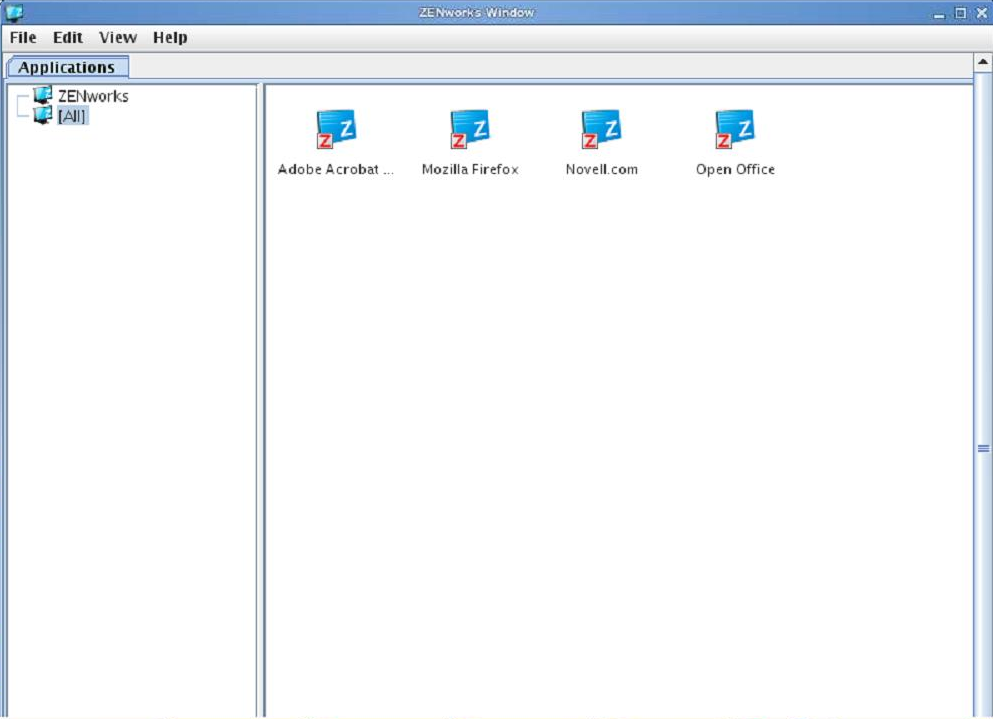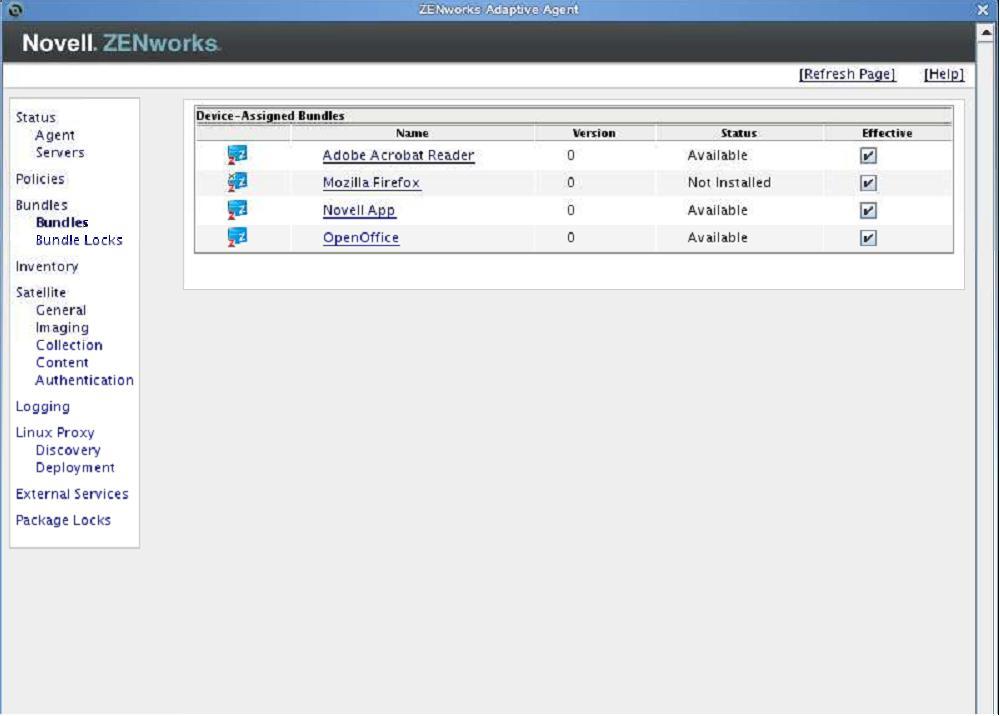5.3 Accessing Bundles
The ZENworks Adaptive Agent provides two ways for accessing the bundles that are assigned to you: the ZENworks Window and the ZENworks Icon.
5.3.1 ZENworks Window
The ZENworks Window is a standalone application that you can launch by using any one of the following options:
Option 1:
In the notifications area of the Linux-managed device, right-click the ZENworks Icon  , then select
, then select
Option 2: To launch the ZENworks Window on the managed device, follow the instructions provided for specific platforms supported by the device.
-
On GNOME desktops:
-
RHEL 4: Select > > .
-
RHEL 5: Select > > .
-
SUSE 10 or 11: Click , then select > > > .
You do not need to select the tab if you have previously launched the ZENworks Window on the device.
-
-
On KDE desktops:
-
RHEL 4: Right-click the Red Hat icon
 , then select > .
, then select > .
-
RHEL 5: Right-click the Red Hat icon
 , then select >.
, then select >.
-
SUSE 10: Right-click the Application Launcher icon
 , then select > > .
, then select > > .
-
SUSE 11: Right-click the Application Launcher icon
 , then select > > > .
, then select > > > .
-

The ZENworks Window left pane displays the following:
-
[All] folder: Contains all bundles that have been distributed to you, regardless of the folder in which they are located.
-
ZENworks folder: Contains all bundles that have not been assigned to a different folder. The ZENworks folder is the default folder for bundles; however, the administrator can create additional folders for organizing bundles and even rename the ZENworks folder.
When you select a folder in the left pane, the right pane displays the bundles that the folder contains. You can:
-
Install a bundle or launch an application for an already installed bundle.
-
View the properties of the bundle. The properties include a description of the bundle, information about people to contact for help associated with the bundle, the times when the bundle is available for use, and the system requirements established for the bundle.
-
Repair an installed application.
-
Uninstall an application. This is an administrator-controlled feature that might not be enabled.
-
Postpone Operation. This feature allows a user to postpone the download of contents until the next refresh. The postpone operation appears only when the content being downloaded is fairly large in size.
5.3.2 ZENworks Icon
The ZENworks Icon  is located in the notification area of the Linux-managed devices. You can right-click the icon to display the ZENworks Adaptive Agent properties. Located in the left navigation pane, the link lets you view the bundles that are assigned to your device.
is located in the notification area of the Linux-managed devices. You can right-click the icon to display the ZENworks Adaptive Agent properties. Located in the left navigation pane, the link lets you view the bundles that are assigned to your device.

The bundle list includes the following information:
-
Name: Displays the name of the bundle. Click the name to display the properties of the bundle, including information such as the version, folder, icon, help contacts, and the time schedules. Based on how the bundle is configured in ZENworks Control Center, you might see the following time schedules:
Time Schedule
Details
No Schedule/Default
Indicated that no schedule is configured for the bundle
On a Specific Event
Runs the scheduled action when the specified event is triggered, for example, user login, user logout, or device boot
Relative
Runs the scheduled action relative to a specified number of days, hours, and minutes from the time the device is refreshed
Daily
Runs the scheduled action daily at the specified time
Weekly
Runs the scheduled action on the selected day of the week
Monthly
Runs the scheduled action on the selected day of the month
Yearly
Runs the scheduled action on the selected day of the year
Specific Date and Time
Runs the scheduled action once on the date and time specified
Specific Time Interval
Repeatedly runs the scheduled action every xxx months, weeks, days, hours, and/or minutes from the start time
On Refresh
Runs the scheduled action on device refresh
Always
Indicates the scheduled action is always active
Date Specific
Runs the scheduled action on the specified date
Day Range
Runs the scheduled action during the specified time interval
-
Version: Displays the version of the bundle assigned to the device.
-
Status: Displays the installation status of the bundle.
-
Effective: Displays whether or not the bundle can be used on the device. If the box is selected, the bundle meets all system requirements and schedule constraints to be used. You can click the bundle icon
 to launch the bundle.
to launch the bundle.
If the box is not selected, the bundle cannot be used. To find out why, click the bundle name to display the system requirements and schedule properties.